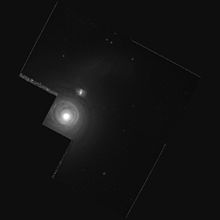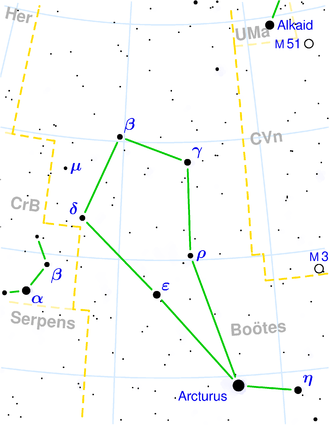NGC 5614
| Galaxy NGC 5614 |
|
|---|---|

|
|
| Image of the galaxies NGC 5613 , NGC 5614 and NGC 5615 (from right to left) with an 80 cm telescope. NGC 5613 is right below center. | |
| AladinLite | |
| Constellation | Bear keeper |
|
Position equinox : J2000.0 , epoch : J2000.0 |
|
| Right ascension | 14 h 24 m 07.6 s |
| declination | + 34 ° 51 ′ 32 ″ |
| Appearance | |
| Morphological type | SA (r) from pec |
| Brightness (visual) | 11.7 mag |
| Brightness (B-band) | 12.5 mag |
| Angular expansion | 2.4 '× 2.0' |
| Position angle | 130 ° |
| Surface brightness | 13.3 mag / arcmin² |
| Physical data | |
| Affiliation | LGG 380 |
| Redshift | 0.012982 ± 0.000030 |
| Radial velocity | (3892 ± 9) km / s |
|
Stroke distance v rad / H 0 |
(177 ± 12) · 10 6 ly (54.4 ± 3.8) Mpc |
| history | |
| discovery | William Herschel |
| Discovery date | May 1, 1785 |
| Catalog names | |
| NGC 5614 • UGC 9226 • PGC 51439 • CGCG 192-014 • MCG + 06-32-022 • IRAS 14220 + 3505 • 2MASX J14240759 + 3451320 • Arp 178 NED03 • VV 77 • GC 3880 • H II 420 • h 1804 • LDCE 1052 NED009 | |
NGC 5614 is a spiral galaxy of Hubble type Sab in the constellation Bootes . Together with her companions NGC 5613 and NGC 5615 , she forms the interactive trio Arp 178 . Halton Arp organized his catalog of unusual galaxies into groups according to purely morphological criteria. This galaxy belongs to the class galaxies with narrow opposing arms .
The galaxy was discovered on May 1, 1785 by the German-British astronomer William Herschel .
NGC 5614 group ( LGG 380 )
| Galaxy | Alternative name | Distance / million Lj |
|---|---|---|
| NGC 5614 | PGC 51439 | 177 |
| NGC 5533 | PGC 50973 | 176 |
| NGC 5579 | PGC 51236 | 164 |
| NGC 5615 | PGC 51435 | 180 |
Web links
literature
- Jeff Kanipe and Dennis Webb: The Arp Atlas of Peculiar Galaxies - A Chronicle and Observer's Guide , Richmond 2006, ISBN 978-0-943396-76-7
Individual evidence

The galaxies NGC 5614 and, smaller NGC 5615, in a high-resolution image from the Hubble Space Telescope
